
The traffic rules describe how a road user must act on the public road, which includes obligations but also advice on how to drive sensibly and safely. All road users must know and apply the traffic rules.
Driving is a very complex skill, because you often have to perform with different actions at the same time. Here you will find the basis for safe driving.
Check the vehicle owner’s manual for how to best start the vehicle. Make sure the parking brake is on before you start the vehicle. If the vehicle has a manual transmission, it must not be in gear. In some vehicles, the clutch must be depressed. For a vehicle that has an automatic transmission, you must put the shift selector in 'park.'
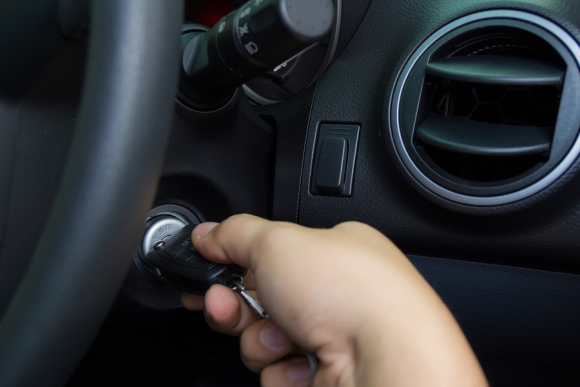 Turn the ignition key to the right to start a car.
Turn the ignition key to the right to start a car.
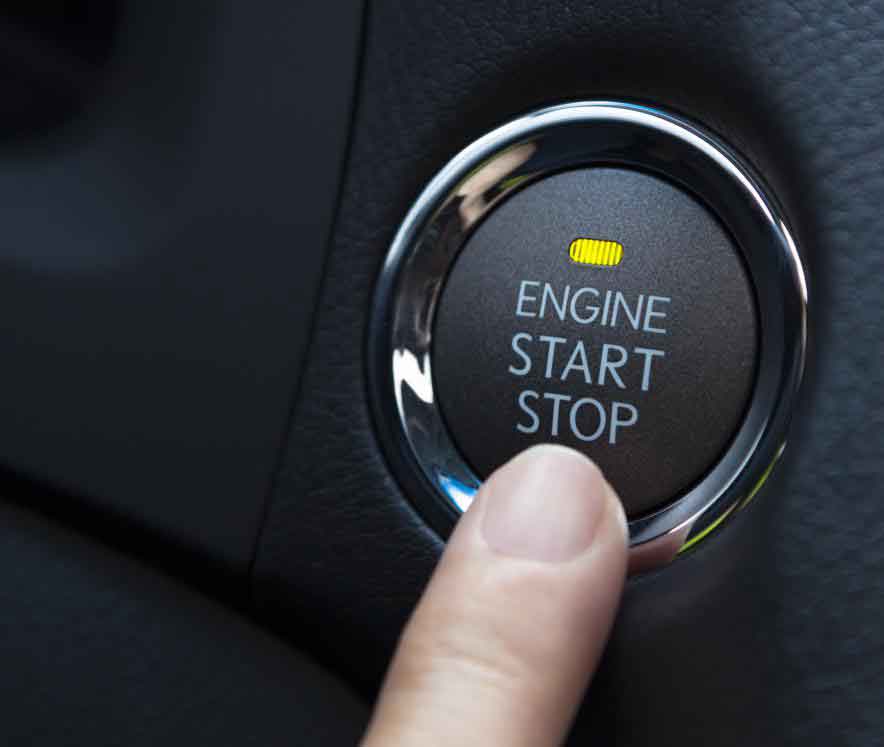 A start-stop system ensures that the engine shuts off automatically when the car stops.
A start-stop system ensures that the engine shuts off automatically when the car stops.
Accelerate gradually and smoothly. Trying to start too fast can cause the drive wheels to spin, particularly on slippery surfaces, and cause the vehicle to slide. With a manual-shift vehicle, practice using the clutch and accelerator so that the engine does not over accelerate or stall when shifting between gears.
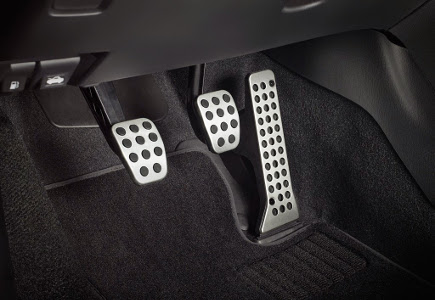 The throttle pedal allows you to increase or decrease the vehicle speed.
The throttle pedal allows you to increase or decrease the vehicle speed.
 On the dashboard is a tachometer on which you can read the engine speed.
On the dashboard is a tachometer on which you can read the engine speed.
Steering is the collection of components, linkages, etc. which allows any vehicle to follow the desired course. The primary purpose of the steering system is to allow the driver to guide the vehicle. Both hands should be placed on opposite sides of the steering wheel (i.e., left hand between 8 and 10 o’clock and right hand between 2 and 4 o’clock). This position is comfortable and on high-speed roads it allows you to make turns without taking your hands from the wheel.
 In case of road damage or crosswind, hold the steering wheel firmly with both hands.
In case of road damage or crosswind, hold the steering wheel firmly with both hands.
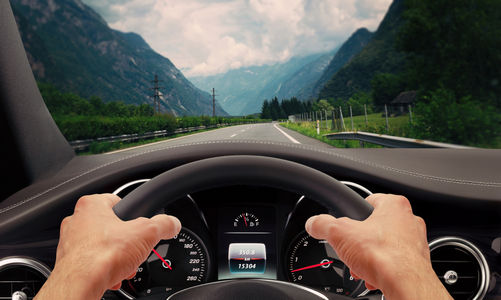 Power steering ensures that you can steer with less effort.
Power steering ensures that you can steer with less effort.
To be a good driver, you must know what is happening around your vehicle. You must look ahead, to the sides, and behind your vehicle. Scanning helps you to see problems ahead; vehicles and people that may be in the road by the time you reach them, signs warning you of problems ahead, and signs giving you directions.
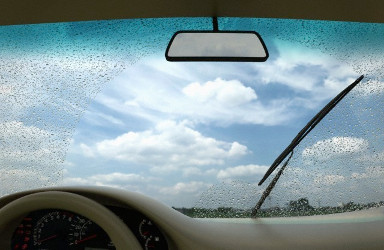 A broken or dirty windshield window can obstruct the view.
A broken or dirty windshield window can obstruct the view.
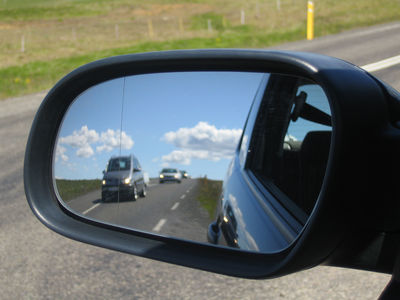 Look closely in the mirrors and watch out for blind spots.
Look closely in the mirrors and watch out for blind spots.
Parking is the act of stopping and disengaging a vehicle and leaving it unoccupied. Parking on one or both sides of a road is often permitted, though sometimes with restrictions. Some buildings have parking facilities for use of the buildings' users. Countries and local governments have rules for design and use of parking spaces. Drivers are responsible for making sure that their vehicle is not a hazard when it is parked. Park your vehicle at a place where it is allowed and make sure it is clearly visible for other road users.
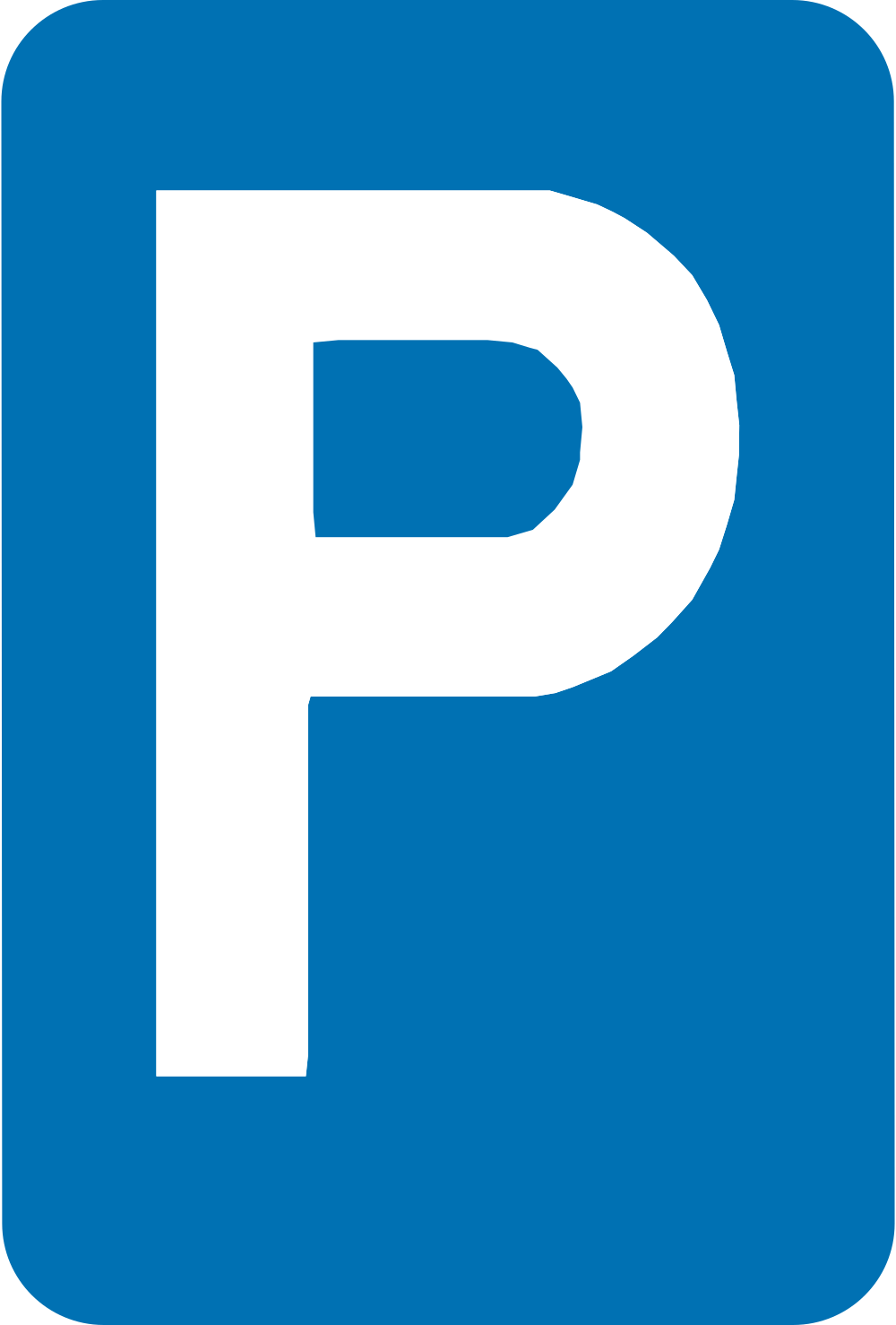 Parking allowed.
Parking allowed.
 Parking prohibited.
Parking prohibited.
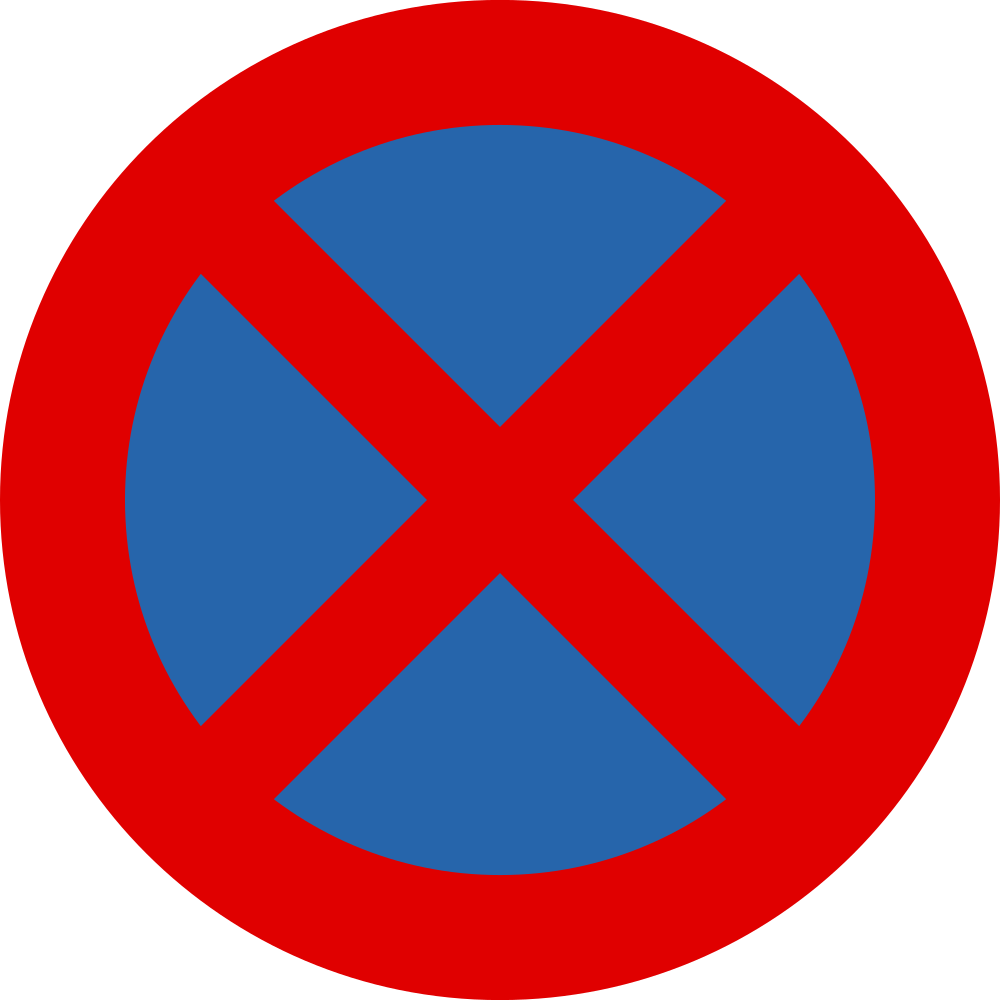 Parking and stopping prohibited.
Parking and stopping prohibited.
Overtaking or passing is the act of one vehicle going past another slower moving vehicle, travelling in the same direction, on a road. When a vehicle is driving slower than the maximum speed, you can overtake the vehicle on the left. Overtaking is a very dangerous maneuver. Only overtake if there is enough space and if the road is completely free. When overtaking a pedestrian, cyclist or moped, there must be at least 1 meter distance. Overtaking is prohibited at crossroads, slopes, dangerous curves and crossings.
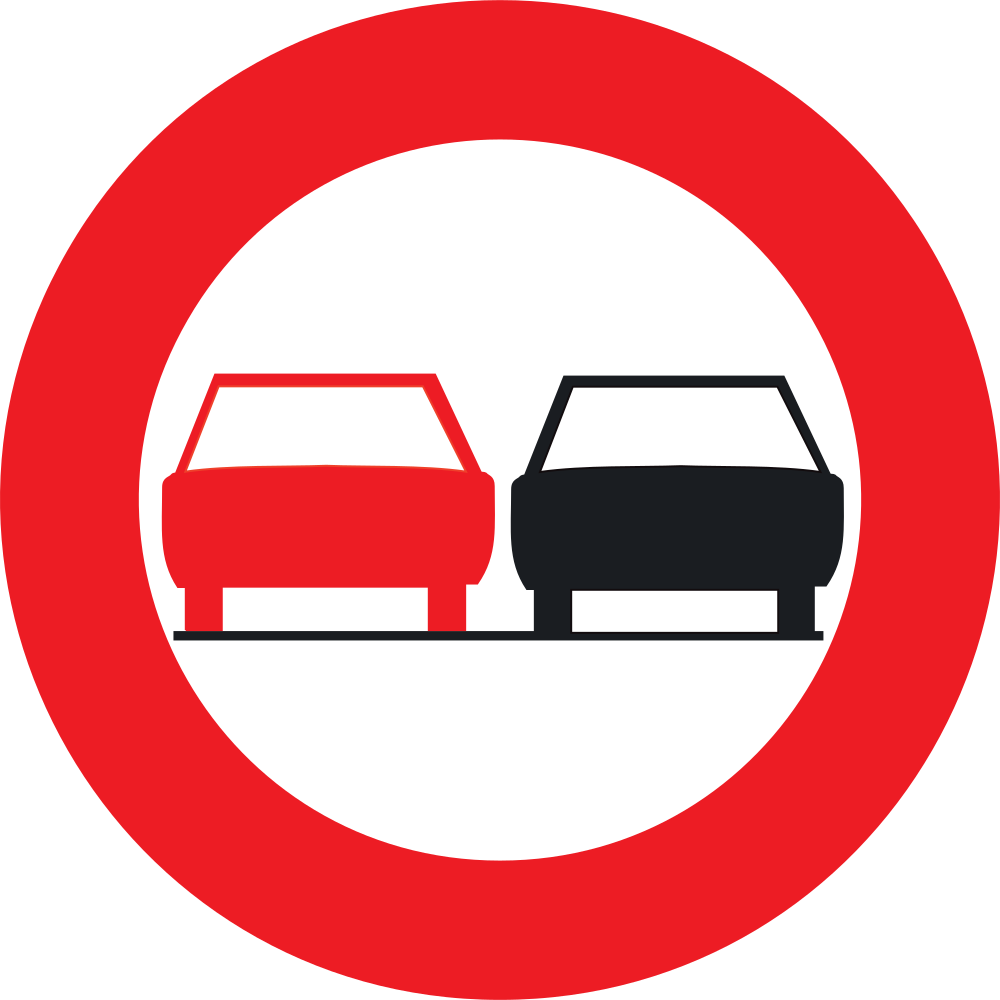 Overtaking prohibited.
Overtaking prohibited.
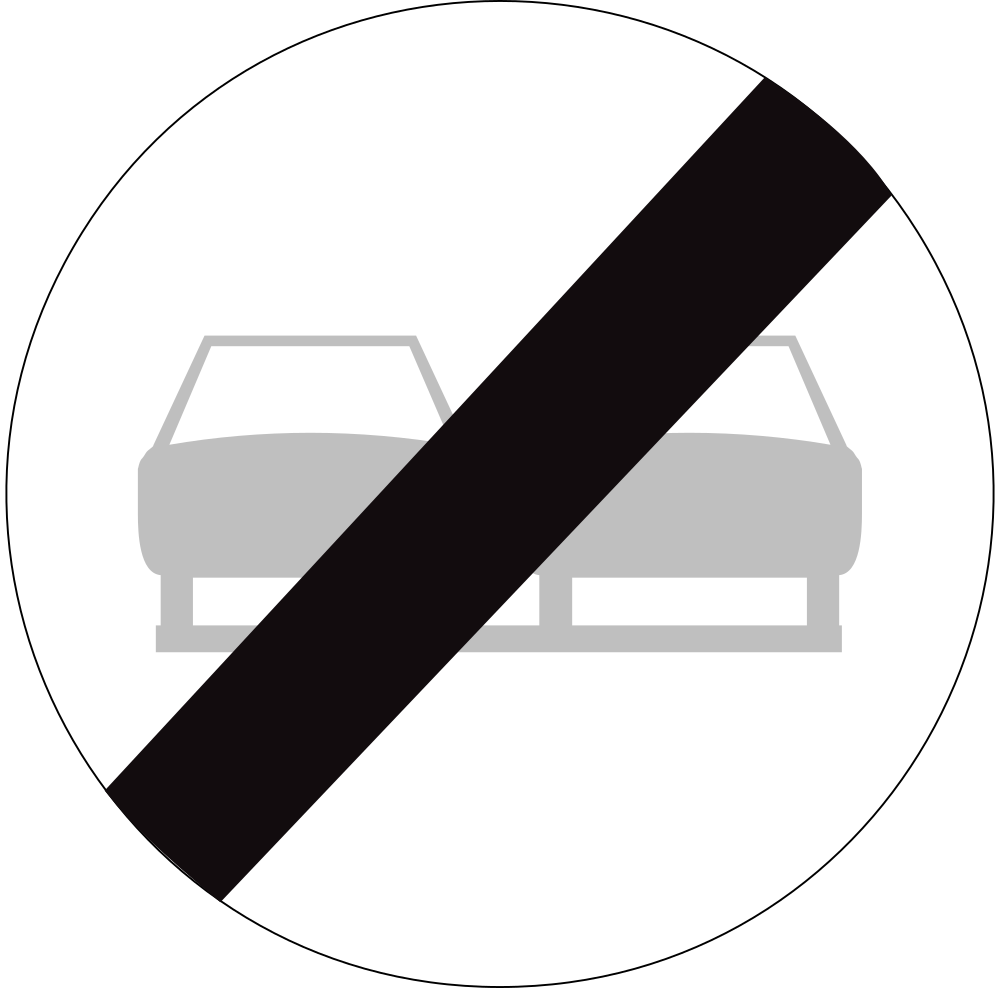 End of the overtaking prohibition.
End of the overtaking prohibition.
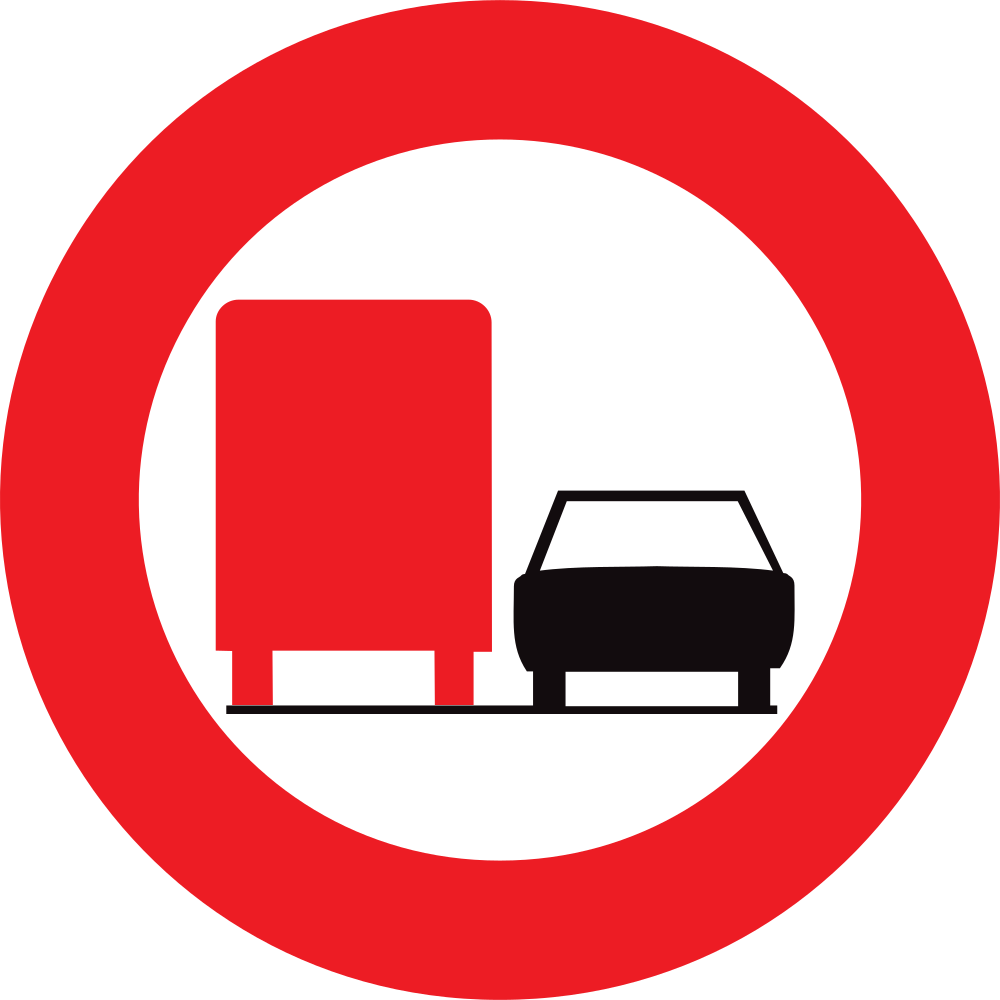 Overtaking prohibited for trucks.
Overtaking prohibited for trucks.
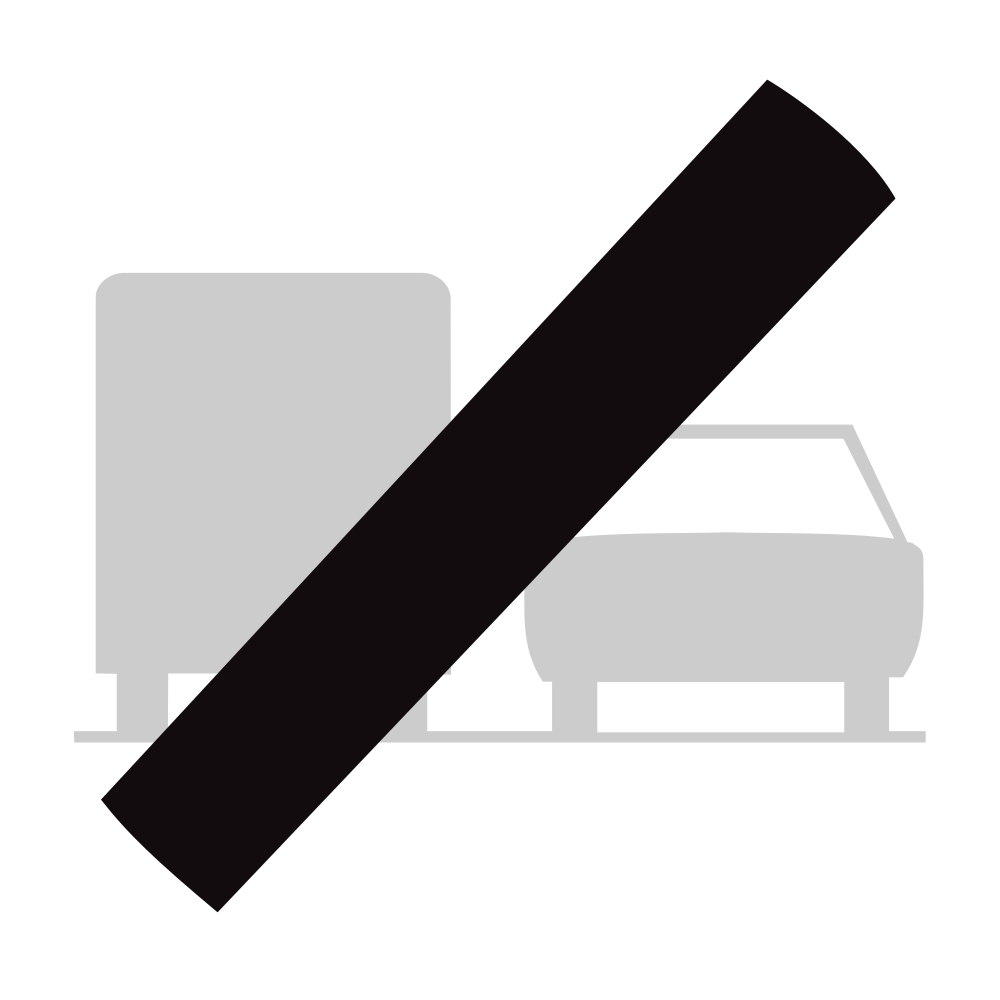 End of the overtaking prohibition for trucks.
End of the overtaking prohibition for trucks.
Reversing is usually done when parking the vehicle. Drivers do not expect a vehicle to be reversing towards them and may not realize it until it is too late. If you miss your turn or exit, do not reverse but go on to where you can safely turn around.
 Check the blind spots and mirrors when reversing.
Check the blind spots and mirrors when reversing.
 Some vehicles have a rear view camera because it shows the entire blind spot behind the car.
Some vehicles have a rear view camera because it shows the entire blind spot behind the car.
A driver must always have his identity card and driving license with him. A registration certificate, certificate of conformity, insurance certificate and proof of inspection must be present in the vehicle. All documents must be original, a copy is not valid.
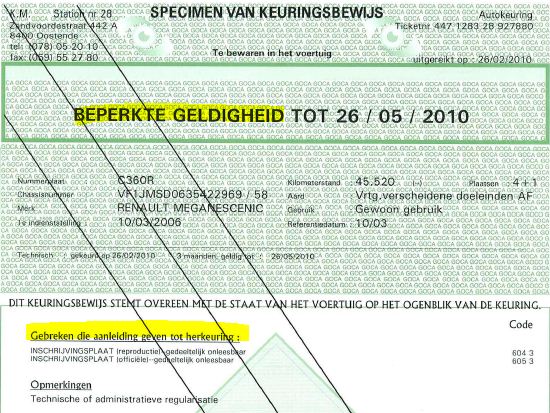 If your vehicle is in order you will receive a green inspection certificate.
If your vehicle is in order you will receive a green inspection certificate.
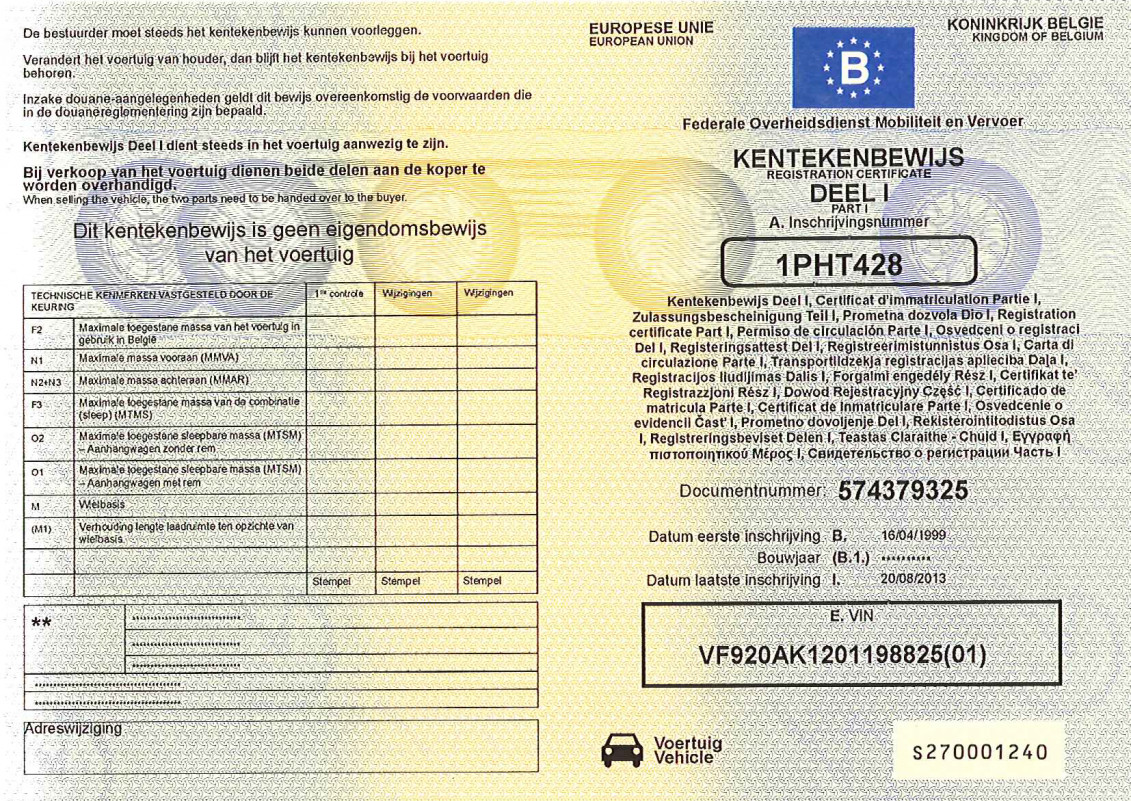 You must keep part 1 of the registration certificate in your vehicle.
You must keep part 1 of the registration certificate in your vehicle.
An identity card is any document that may be used to prove a person's identity. Some countries issue formal identity documents, as national identification cards which may be compulsory or non-compulsory, while others may require identity verification using regional identification or informal documents. When the identity document incorporates a person's photograph, it may be called photo ID. In the absence of a formal identity document, a driving license may be accepted in many countries for identity verification.
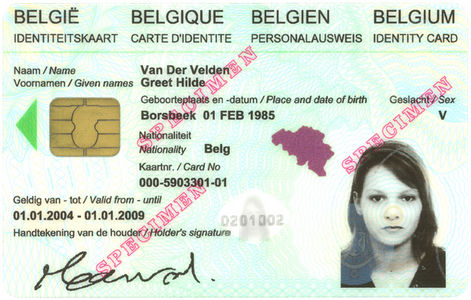 This is the front of the Belgium identity card.
This is the front of the Belgium identity card.
 This is the back of the Belgium identity card.
This is the back of the Belgium identity card.
A driving license is a document with which a driver of a motor vehicle can demonstrate that he / she has sufficient knowledge, insight and skills to be able to drive a motor vehicle of a certain category.
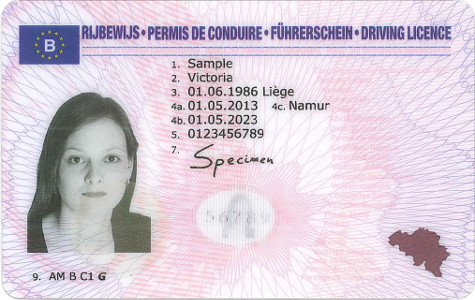 This is the front of the Belgium driving license.
This is the front of the Belgium driving license.
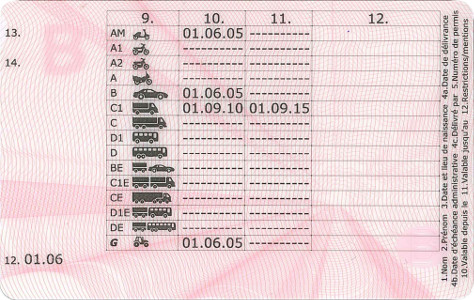 This is the back of the Belgium driving license.
This is the back of the Belgium driving license.
A vehicle registration certificate is an official document providing proof of registration of a vehicle. It is used primarily by governments as a means of ensuring that all road vehicles are on the national vehicle register, but is also used as a form of law enforcement and to facilitate change of ownership when buying and selling a vehicle.
 You must keep part 1 of the registration certificate in your vehicle.
You must keep part 1 of the registration certificate in your vehicle.
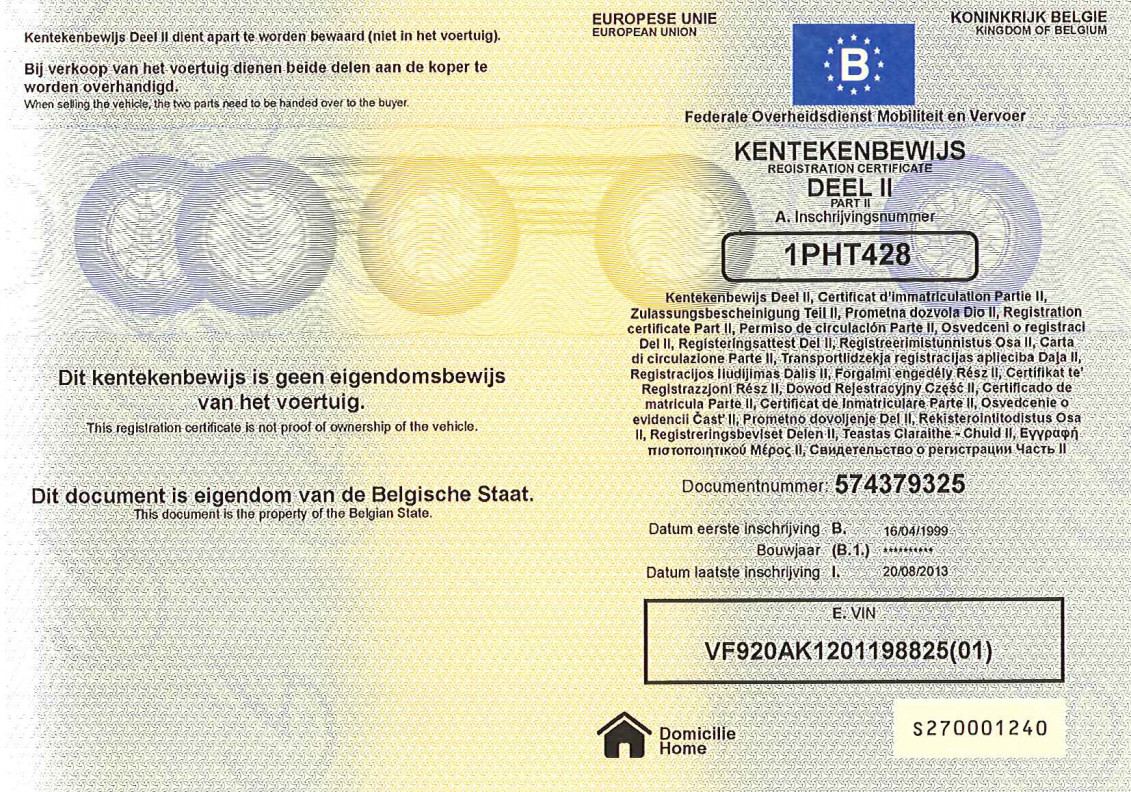 You must keep part 2 of the registration certificate at home.
You must keep part 2 of the registration certificate at home.
Type approval or certificate of conformity is granted to a product that meets a minimum set of regulatory, technical and safety requirements. Generally, type approval is required before a product is allowed to be sold in a particular country, so the requirements for a given product will vary around the world. Processes and certifications known as type approval in English are generally called homologation, or some cognate expression, in other European languages.
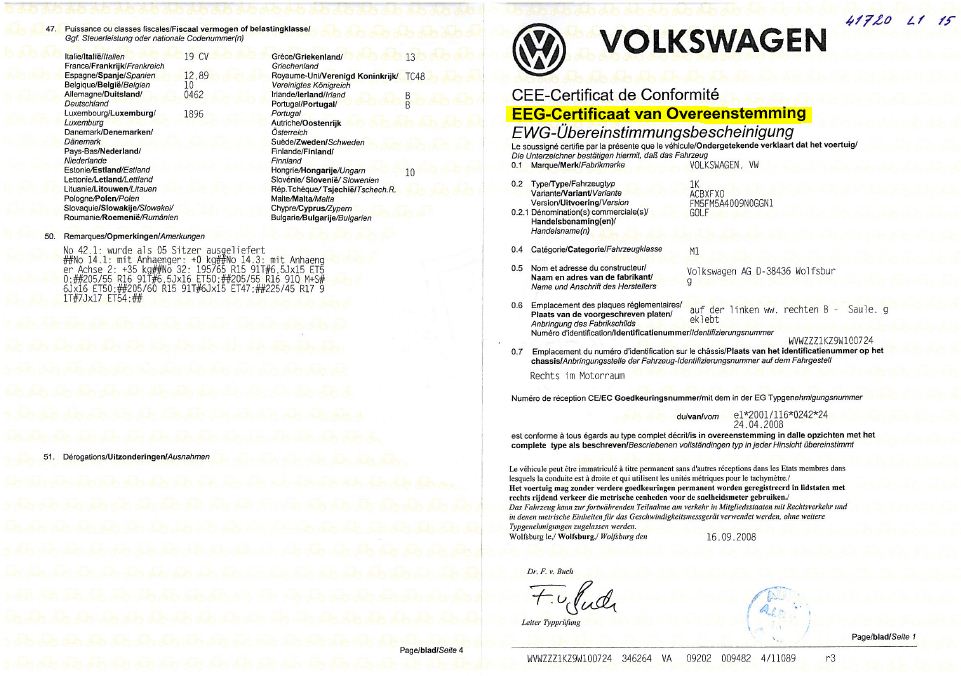 A certificate of conformity from a Volkswagen.
A certificate of conformity from a Volkswagen.
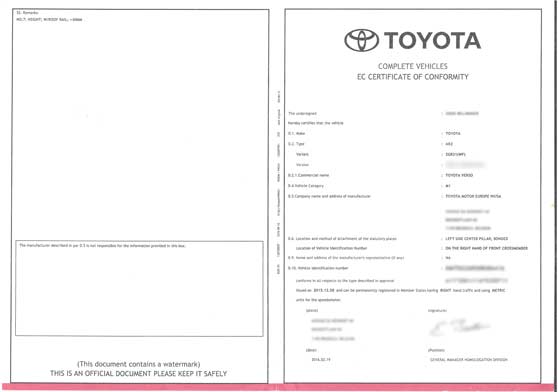 A certificate of conformity from a Toyota.
A certificate of conformity from a Toyota.
An International Motor Insurance Card System is an arrangement between authorities and insurance organizations of multiple states to ensure that victims of road traffic accidents do not suffer from the fact that injuries or damage sustained by them were caused by a visiting motorist rather than a motorist resident in the same country. Additionally to extending the insurance coverage territorial scope such systems have the benefit for motorists to avoid the need to obtain insurance cover at each of the frontiers of the countries which they visit.
 The insurance certificate indicates that you have valid car insurance.
The insurance certificate indicates that you have valid car insurance.
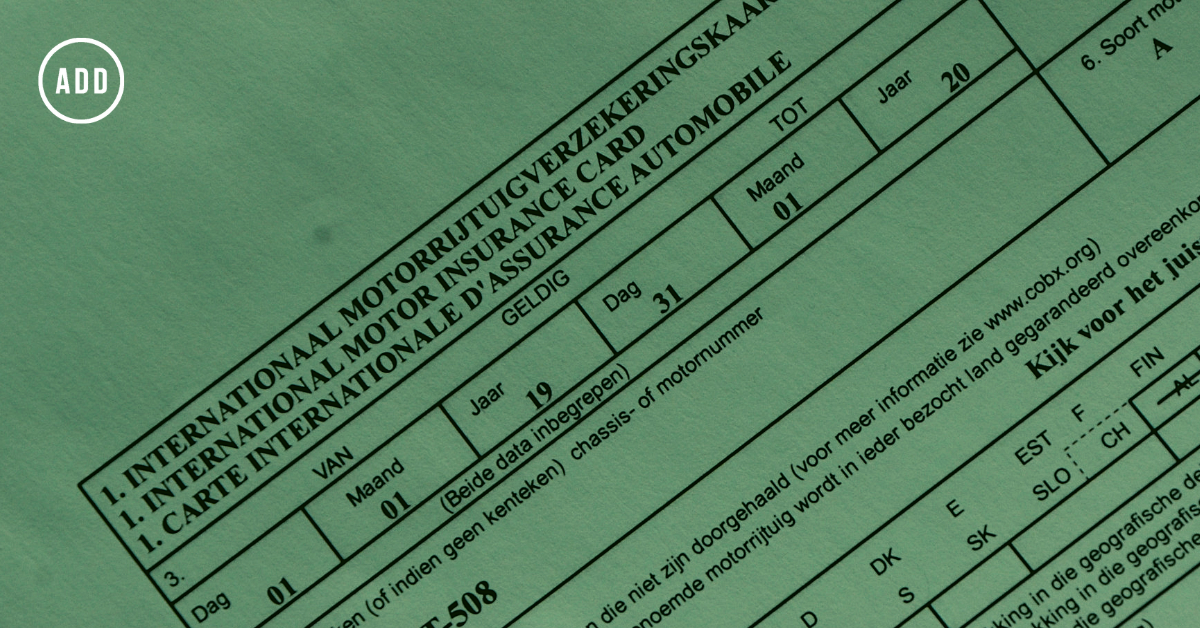 A car insurance is required by law when you go on public roads.
A car insurance is required by law when you go on public roads.
The inspection certificate indicates that your vehicle is technically approved. When your car is 4 years old, you must go to the inspection annually. You will receive an invitation for this. During the inspection, the inspection center checks the exhaust emission, the mechanical condition of the car and the operation of the brakes, lights and steering.
 If your vehicle is in order you will receive a green inspection certificate.
If your vehicle is in order you will receive a green inspection certificate.
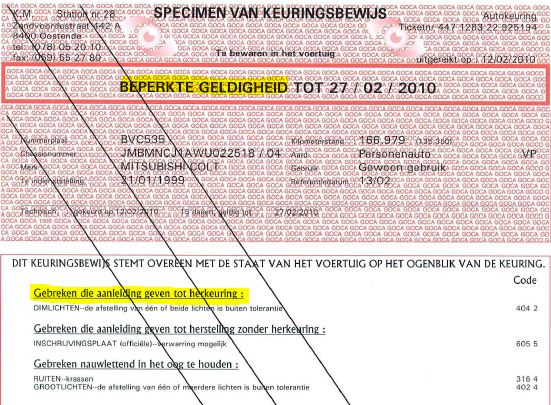 If your vehicle is not in order, you will receive a red inspection certificate, you must come back for a re-inspection.
If your vehicle is not in order, you will receive a red inspection certificate, you must come back for a re-inspection.
The following attributes must also be present in a vehicle: warning triangle, first aid kit, fire extinguisher and a fluo vest. A spare wheel, jack, gps, parking disc and traction cable are not required, but can be useful.
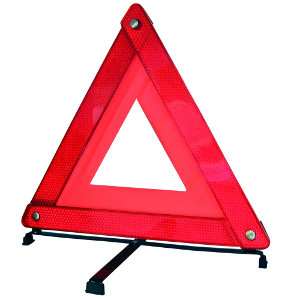 A warning triangle to warn for an accident.
A warning triangle to warn for an accident.
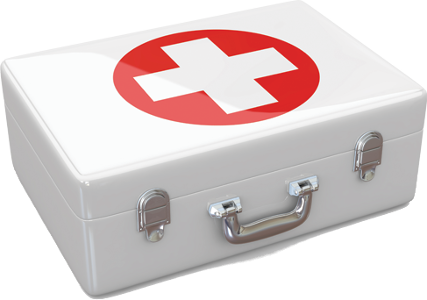 A first aid kit to provide first aid.
A first aid kit to provide first aid.
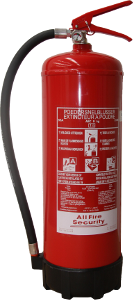 A fire extinguisher to extinguish a small fire.
A fire extinguisher to extinguish a small fire.
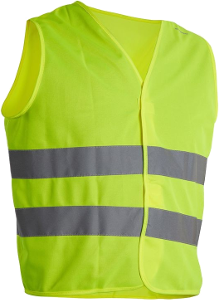 A fluorescent vest to be visible when you have to leave your vehicle.
A fluorescent vest to be visible when you have to leave your vehicle.